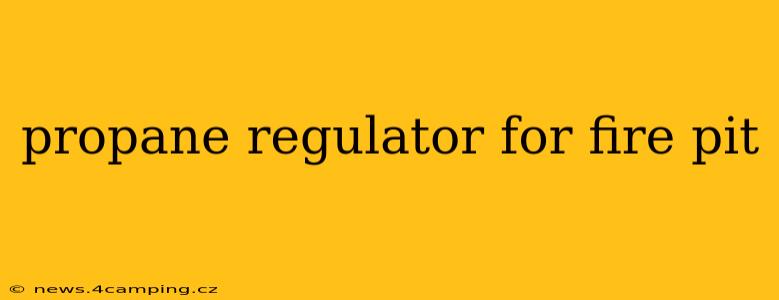Choosing the right propane regulator for your fire pit is crucial for safety and performance. A malfunctioning regulator can lead to dangerous gas leaks or insufficient flame, ruining your outdoor enjoyment. This guide will help you understand the different types of regulators, their features, and how to select the best one for your needs.
What is a Propane Regulator and Why is it Important?
A propane regulator is a safety device that reduces the high pressure of propane gas from the tank to a lower, safer pressure suitable for your fire pit's burner. Without a regulator, the high-pressure gas could cause dangerous explosions or fires. The regulator also controls the flow of gas, allowing you to adjust the flame height. This makes it a critical component for both safety and usability.
Types of Propane Regulators for Fire Pits
Several types of propane regulators are available, each designed for specific applications and flow rates. The most common types are:
- Low-pressure regulators: These are commonly used for fire pits and other low-pressure appliances. They reduce the tank pressure to around 11 inches of water column (WC). This is generally the type you'll need for your fire pit.
- High-pressure regulators: These regulators are designed for higher-pressure applications and are generally not suitable for fire pits.
- Single-stage regulators: These reduce the propane pressure in one step. They are the most common type used for fire pits due to their simplicity and reliability.
- Two-stage regulators: These reduce the pressure in two steps, offering more precise pressure control. While less common in fire pits, they can be beneficial for larger setups or those needing very fine flame adjustments.
What Size Propane Regulator Do I Need for My Fire Pit?
The size of the regulator you need depends on the BTU (British Thermal Unit) rating of your fire pit. This information should be found in your fire pit's owner's manual. The BTU rating indicates the amount of heat the fire pit produces per hour. Higher BTU ratings generally require higher flow rate regulators. Always choose a regulator with a flow rate that meets or exceeds your fire pit's requirements to ensure safe and optimal performance. Don't underestimate the importance of checking the BTU rating before purchasing a regulator.
What if I don't know my fire pit's BTU rating?
If you can't find the BTU rating, contact the manufacturer of your fire pit or consult an expert. Trying to guess can lead to dangerous situations.
How to Connect a Propane Regulator to Your Fire Pit
Connecting a propane regulator involves attaching it to the propane tank and then to the fire pit. Always refer to your fire pit's instruction manual for specific connection instructions. However, generally, it involves tightening the connections securely using appropriate wrenches. Never force any connections. If you're unsure, seek professional help.
Is it difficult to connect a propane regulator to a fire pit?
Connecting a regulator is usually straightforward, but it's crucial to follow the instructions carefully and ensure all connections are tight and leak-free. If you are uncomfortable performing this task, consult a professional. Safety should always be your top priority.
How to Check for Propane Leaks
Regularly checking for propane leaks is crucial for safety. Use a soapy water solution to check all connections for bubbles, indicating a leak. If you detect a leak, immediately turn off the propane tank and contact a professional for assistance. Never attempt to repair a propane leak yourself unless you are a qualified technician.
What should I do if I suspect a propane leak?
Immediately turn off the propane tank valve and move away from the area. Ventilate the space well and contact a qualified propane technician or emergency services. Never use a flame to check for a leak.
Maintaining Your Propane Regulator
Regular maintenance of your propane regulator can extend its lifespan and ensure safe operation. Inspect the regulator regularly for any signs of damage, corrosion, or leaks. If you notice any problems, replace the regulator immediately.
How often should I replace my propane regulator?
While there isn't a strict timeframe for replacement, it's generally recommended to replace your regulator every few years, or sooner if you notice any signs of damage or wear. This proactive approach prioritizes safety.
By following these guidelines, you can select and maintain the correct propane regulator for your fire pit, ensuring safe and enjoyable use. Remember, safety should always be your top priority when handling propane.
